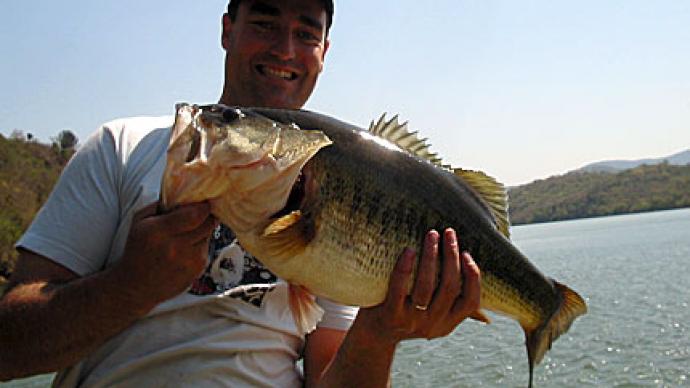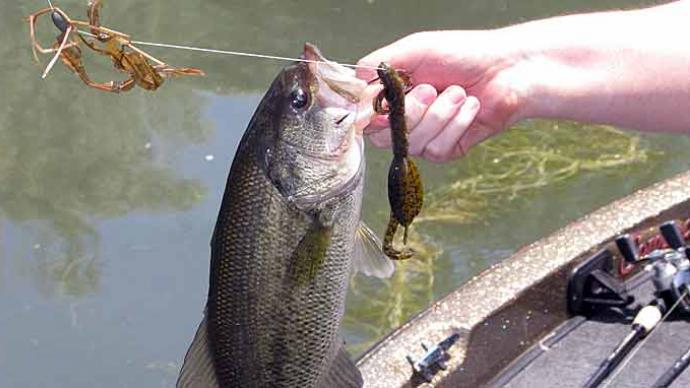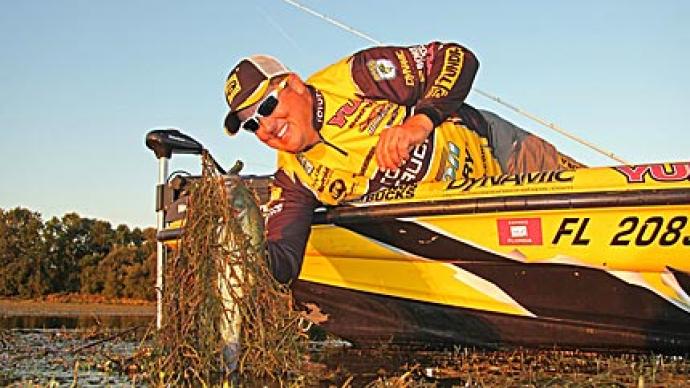
For years growing up, my father and I would take trips during the fishing season to Long Point Bay in Lake Erie. The bay is a host to varieties of structure, just about anything you can shake a stick at. Rocks, sandbars, humps, sunken islands, docks, laydowns, brush, and even shipwrecks! But perhaps the easiest and most reliable place to find fish is in the weeds.
There are a host of reasons for bass to be in the weeds. The weeds are a constant oxygen source, which attracts baitfish and crawfish, which are food for the bass. Weeds also offer a place for the bass to lie in ambush, waiting for an unsuspecting meal to pass by. And in fairly dense masses, weeds offer shade from the blaring hot sun. Weedbeds are heaven to a bass if you think about it!
Bass are found in weeds year-round, making them a very reliable place to catch fish consistently. But how do you go about fishing this type of cover? The ways to fish a weedbed are endless and have to do with the time of day, season, and temperature.
I almost always start by throwing spinnerbaits along the edges. This way, you can target the active bass sitting near the edges, waiting for schools of minnows (or your spinnerbait) to pass by. If they are active, you will almost always provoke strikes this way.
To target the active bass in the center of the weed masses, I like to throw a jerkbait or spinnerbait over the weeds (if possible) and knick the tops of the weeds. In the early morning, you can throw a topwater like a buzzbait or Zara Spook over the weeds, which will most likely pay off. In weeds that extend to the surface, you may want to target the active bass with a weedless spoon like a Moss Boss or even a weedless in-line spinner.
But what about when bass aren't active? Sure, it's great to get there around mealtime, but those bass don't eat all day long (although sometimes it seems quite the contrary). So what you'll need to do is slow down your presentation.
You can still catch bass on the edges; some anglers only fish the edges. I believe this is a mistake because I have caught much bigger bass on the middle mass of weedbeds. However, I still fish the edges if I must fill out a limit.
An excellent way to cover the edges for lethargic bass is with the simple stop & go retrieve of a jerkbait, suspending if possible. Let the lure sit for a good period between jerks. Soft jerkbaits like Slug-Gos or Bass Assassins are also a good choice, as you can let them sink right into the weeds and rip them out quickly, which often provokes a strike from inactive bass.
When targeting inactive bass in the center of the weedbed, you can still use the two strategies just mentioned, but I believe the bass still have to be half-feeding for that to work. You'll probably want to switch to a Texas-rigged plastic worm or lizard and go quietly over the bed, dropping the worm into any holes in the weeds. Set the hook when you feel any difference, even a little tap. Be sure to use heavy lines to keep bass from tangling themselves in the heavy weeds.
What weedbeds should you fish? My general rule is that any green weeds that offer shade/oxygen to the fish should be good enough to fish. Any weed flats with other cover mixed in (like rocks or tree stumps) are definite areas to fish because they offer that extra bit of attraction to a lunker bass. Avoid brown weeds as they are dead and use up oxygen instead of giving it. Bass avoid them, and you should too.
For shallower variations of weeds (i.e., Lily Pads or Bullrushes), you'll probably want to again spinnerbait the edges first to try for active bass. However, weeds can quickly foul up your spinnerbait and bend it out of shape, so I suggest using a good quality titanium Terminator P1 series spinnerbait. Soft jerkbaits, once again, are great for these situations because they are versatile and can be skipped into holes in the weeds or even reeled underneath undercut banks.
When the fish are inactive in these areas, you'll want to slow it down again (do we see a pattern here?). My favorite way to fish pads or bullrushes is with a finesse flippin' jig with a pork or plastic trailer to allow the bait to fall slowly. Let the jig sit on the bottom and jiggle it slowly, or sometimes raise it off the bottom and let it drop again. Finesse-style jigs allow you to get into tight areas. Terminator's line of finesse jigs are perfect for these situations.
Color is not of the highest importance, but I like a black/blue or crawfish color because that's what a jig represents.
Some alternatives would be the good old-fashioned Grass Frog, Poppin' Grass Frog, or even a plastic rat lure.
Thank you for reading my article on fishing in the weeds. I hope something in there will help you catch more bass. Good luck to all, and tight lines!




